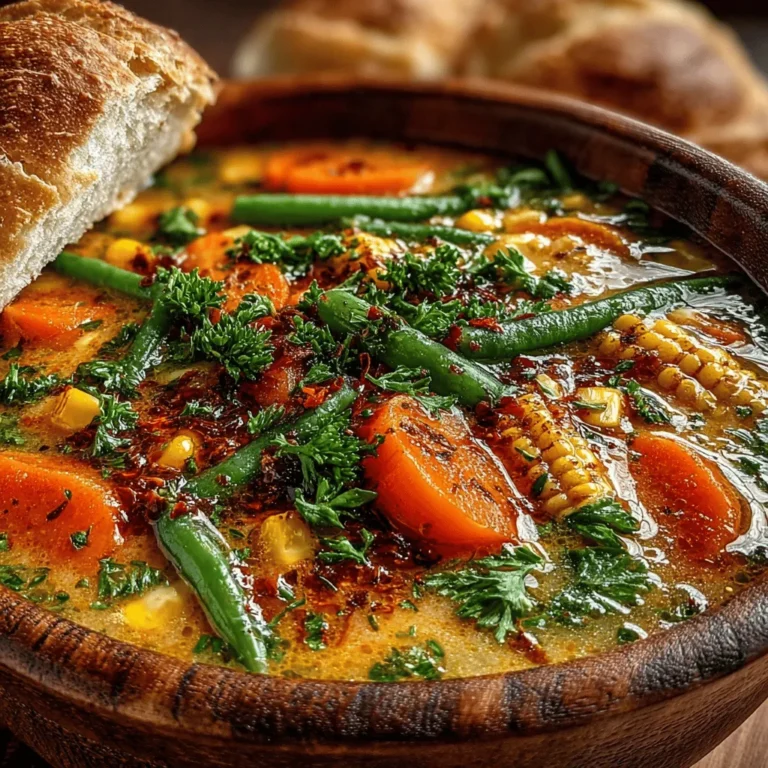Warm and Wholesome Vegetable Chowder: A Comforting Recipe for Every Season
When the temperature drops or the clouds gather, few dishes provide the same level of comfort as a warm bowl of vegetable chowder. This rich and creamy soup is not just a meal; it’s an experience that brings together a medley of fresh vegetables, aromatic herbs, and spices, creating a nourishing dish perfect for any time of year. Whether enjoyed on a chilly winter evening or a cool summer night, vegetable chowder offers a delightful way to savor the flavors of the season.
In recent years, there has been a growing emphasis on the importance of seasonal eating. Utilizing seasonal produce not only ensures that your meals are fresher and more flavorful but also promotes healthier eating habits. Seasonal vegetables are often more nutrient-dense, as they are harvested at their peak, packed with the vitamins and minerals your body needs. By incorporating a variety of colorful vegetables into your chowder, you’re not only enhancing the flavor profile but also creating a dish that is as healthful as it is hearty.
As you prepare to make this warm and wholesome vegetable chowder, you can look forward to a comforting blend of flavors and textures. The creamy base, combined with the crunch of fresh vegetables, makes for a satisfying meal. Each spoonful is a balance of sweetness from the corn, earthiness from the potatoes, and a delightful hint of herbs that ties everything together. This recipe invites you to explore the vibrant taste of vegetables while also providing a sense of warmth and satisfaction.
Understanding the Ingredients
To create the perfect vegetable chowder, it’s essential to understand the role of each ingredient in your recipe. The quality and freshness of your produce will greatly influence the overall flavor and health benefits of the dish.
Olive Oil
Starting with a base of olive oil is not just a matter of flavor; it’s a healthy choice as well. Rich in monounsaturated fats, olive oil is known for its heart-healthy properties, including reducing inflammation and lowering the risk of chronic diseases. The subtle, fruity flavor of olive oil enhances the chowder while allowing the natural flavors of the vegetables to shine through.
Vegetables
The star of any vegetable chowder is, of course, the vegetables themselves. Using fresh, seasonal produce elevates the dish and provides a variety of nutrients. When selecting your vegetables, opt for those that are in season to ensure maximum flavor and health benefits. Seasonal vegetables are not only tastier but also more affordable, making them a sustainable choice for your cooking endeavors.
Onions
Onions form the aromatic base of the chowder. Their sweet and savory notes contribute depth to the flavor profile. As they sauté in olive oil, they release their natural sugars, creating a caramelized effect that enhances the overall dish.
Garlic
No chowder is complete without garlic. This flavorful ingredient not only adds zest but also offers numerous health benefits, including immune-boosting properties and antioxidant effects. The aroma of sautéed garlic is irresistible and sets the tone for the comforting meal that’s about to come.
Carrots and Celery
Carrots and celery are nutritional powerhouses that add both flavor and texture to the chowder. Carrots are rich in beta-carotene and fiber, while celery contains vital vitamins like K and C, as well as potassium. Together, they provide a crunchy contrast to the creaminess of the soup.
Potatoes
Adding heartiness to the chowder, potatoes are essential for creating that comforting, creamy texture. They also serve as a natural thickener, lending a satisfying body to the dish. Choose your favorite variety, whether it’s russet, red, or Yukon gold, to achieve the desired creaminess.
Zucchini
Zucchini is a summer staple that brings a mild flavor and a tender texture to the chowder. Packed with vitamins and minerals, this vegetable also adds moisture and balances the density of the other ingredients.
Corn and Green Beans
For a touch of sweetness and crunch, corn and green beans are excellent additions. Fresh corn, in particular, contributes a burst of flavor that pairs beautifully with the other vegetables, while green beans add vibrant color and a crisp bite.
Broth and Dairy Alternatives
To elevate the flavors of your chowder, a good-quality vegetable broth is essential. It serves as the foundation of the soup, imparting a rich, savory backdrop against which the vegetables can shine. For those who prefer a creamier texture, consider using dairy alternatives like coconut milk or cashew cream. These options provide a rich, velvety consistency without the use of traditional dairy.
Herbs and Seasoning
Herbs and spices are vital for flavor development in vegetable chowder. Fresh thyme and basil provide aromatic notes, while salt and pepper enhance the natural flavors of the ingredients. A sprinkle of freshly chopped herbs just before serving can also add a burst of color and freshness to the dish.
Step-by-Step Preparation of Vegetable Chowder
Before diving into the cooking process, it’s important to prepare your kitchen and gather all the essential tools and utensils needed for making vegetable chowder. Here’s a brief overview of the items you’ll want on hand:
1. Large Soup Pot: A sturdy pot is essential for cooking the chowder. Look for one with a heavy bottom to ensure even heat distribution and prevent sticking.
2. Cutting Board and Sharp Knife: Proper prep work starts with a good cutting board and a sharp knife, which will make chopping vegetables quick and easy.
3. Wooden Spoon or Spatula: A wooden spoon or spatula is perfect for stirring the ingredients and ensuring even cooking without scratching your pot.
4. Measuring Cups and Spoons: Accurate measurements are crucial for achieving the right balance of flavors, so have these handy.
5. Ladle: For serving the chowder, a ladle will make it easy to portion out the soup into bowls without making a mess.
6. Blender or Immersion Blender (optional): If you prefer a smoother texture for your chowder, a blender or immersion blender can help achieve that creamy consistency.
Now that your kitchen is prepared, it’s time to gather your fresh, seasonal ingredients and start cooking!

Heating the Oil and Sautéing Aromatics
To begin our vegetable chowder, heat 2 tablespoons of olive oil in a large pot over medium heat. The oil is essential as it not only prevents sticking but also enhances the flavor of your chowder. Once the oil shimmers, add finely chopped onions, garlic, and celery. Sauté these aromatics for about 5 minutes, stirring occasionally, until the onions become translucent and fragrant. This step is crucial as it lays the foundation for the chowder’s flavor profile. The gentle cooking of these ingredients will release their natural sweetness, creating a savory base that will elevate your dish.
Incorporating Vegetables
Next, it’s time to layer in your vegetables, which should be added in stages to build complexity in flavor. Start by adding diced carrots and potatoes to the pot. These hearty vegetables take longer to cook, so they should be added first. Stir them into the sautéed aromatics, allowing them to cook for about 5-7 minutes until they start to soften. This process allows their flavors to meld with the base of the chowder.
After the initial cooking, add your remaining vegetables—such as zucchini, bell peppers, and corn. These tender vegetables will cook more quickly, so adding them later ensures they retain their vibrant colors and textures. Stir everything together, allowing the vegetables to become acquainted with one another for another 5 minutes. This layering technique is vital; it allows each vegetable to contribute its unique flavor to the chowder, creating a rich and satisfying dish.
Cooking Process
Now that your vegetables are in the pot, it’s time to introduce the broth. Pour in 4 cups of vegetable broth and bring the mixture to a gentle boil. Once boiling, reduce the heat to low and let it simmer uncovered. Simmering is key for flavor melding; it allows the vegetables to release their essence into the broth, resulting in a rich and deep flavor. Let your chowder simmer for at least 20-25 minutes or until the vegetables are tender. Stir occasionally to prevent sticking and to ensure even cooking.
As the chowder simmers, take the opportunity to taste and adjust the seasoning. A pinch of salt and pepper can go a long way in enhancing the overall flavor. If desired, a splash of lemon juice can brighten the dish and add a fresh note, balancing the richness of the chowder.
Achieving the Perfect Creamy Texture
To achieve that signature creamy texture, you have a few options. If you prefer a lighter chowder, you can simply stir in 1 cup of unsweetened almond milk or another plant-based milk towards the end of cooking. For a richer, creamier consistency, consider using heavy cream, coconut cream, or even pureeing a portion of the chowder.
To thicken the chowder, you can also use a simple technique involving the potatoes. As they cook, they will naturally release starches into the broth, thickening it. For an extra creamy texture, take about 1-2 cups of the chowder and blend it in a blender or with an immersion blender until smooth, then return it to the pot. This not only enhances the creaminess but also gives a beautiful, velvety mouthfeel to your chowder.
Nutritional Benefits of Vegetable Chowder
This vegetable chowder is not just delicious; it’s also packed with health benefits. Each ingredient contributes to its nutritional value:
– Vegetables: Rich in vitamins, minerals, and fiber, vegetables like carrots, potatoes, and zucchini support overall health and digestion.
– Broth: A good vegetable broth can provide essential nutrients and hydration.
– Healthy Fats: Olive oil adds heart-healthy fats, which are essential for nutrient absorption.
This chowder serves as a balanced meal option, providing carbohydrates from the potatoes, healthy fats from the oil, and protein from added legumes, if desired. For those following dietary preferences, the chowder can easily be made vegetarian or vegan by ensuring the use of plant-based broth and dairy alternatives. It is also naturally gluten-free, making it a versatile dish for various dietary needs.
Serving Suggestions for Vegetable Chowder
Pair your warm and wholesome vegetable chowder with a side of freshly baked bread rolls or crunchy crackers for a complete meal. The bread is perfect for dipping, soaking up the rich flavors of the chowder.
When it comes to toppings, the possibilities are endless. A sprinkle of shredded cheese adds a creamy and savory note, while croutons provide a delightful crunch. Fresh herbs like parsley or chives can enhance both the flavor and presentation of your dish. For those who enjoy a bit of spice, a dash of hot sauce or a sprinkle of red pepper flakes can elevate your chowder to new heights.
This chowder is ideal for various occasions. Whether you’re hosting a family dinner, enjoying a cozy night in, or preparing meals for the week, vegetable chowder fits the bill. Its comforting nature makes it a go-to for gatherings, and it’s easy to make in large batches for meal prep.
Storing and Reheating Leftover Chowder
When it comes to storing leftover chowder, the best practice is to transfer it to an airtight container. Make sure it has cooled to room temperature before sealing it. Store in the refrigerator for up to 3-4 days. If you want to extend its shelf life, consider freezing the chowder. It can be stored in freezer-safe containers or bags for up to 3 months.
When reheating, it’s essential to do so gently to preserve the texture and flavor. If reheating from frozen, let it thaw in the refrigerator overnight. To reheat, place the chowder in a pot over low heat, stirring frequently until warmed through. If the chowder has thickened in the fridge, you may need to add a splash of vegetable broth or water to reach your desired consistency.
Conclusion
In summary, making vegetable chowder is a rewarding experience that not only fills the belly but also nourishes the soul. With its health benefits, versatility, and comforting nature, this recipe is perfect for anyone looking to enjoy a wholesome meal. Don’t hesitate to experiment with seasonal vegetables or personal variations to make it your own.
Homemade vegetable chowder is the perfect way to embrace the flavors of fresh ingredients while providing a nourishing choice for any meal. So gather your vegetables, heat up that pot, and let the warmth of homemade chowder fill your home and your heart. Enjoy!


